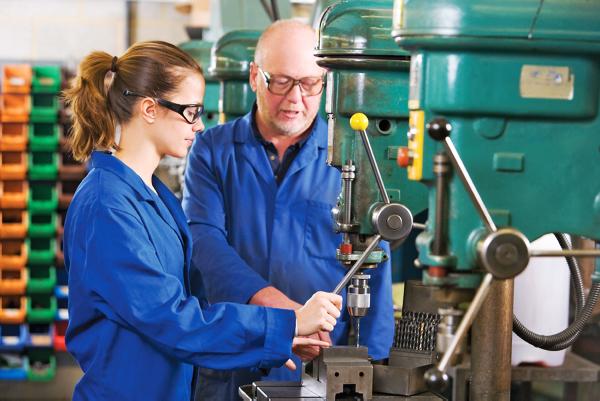If there’s one area that took a battering during the recession it’s apprenticeships. When looking at the figures for the last 20 years, apprenticeship registrations reached a peak of 8,306 in 2006. By 2010, this had dropped to 1,204 – an 86% drop. By the end of last year things had improved, although not hugely, as 1,929 apprenticeships were registered (see figure 1).
It won’t shock anyone that construction apprenticeships took the biggest hit. In 2006 there were 4,514 construction apprenticeships registered. By 2010 this figure had dropped to just 244.
They had only made a marginal recovery by the end of last year – to the tune of 380 to be exact (see figure 2). John McGrath, manager of the skills and labour market research unit at Solas, says the reason for the slow growth in construction is that most of the houses built in recent years are self-builds.
“There’s virtually no building of estates where there would be big numbers of workers.”
However, while this might sound depressing, aspiring to replicate 2006 figures is in vain. John says the number of apprenticeships registered in 2006 was a “complete aberration and we’ll never have that again.”
He has a point. Looking back to 1994, just 1,046 apprenticeships were registered in Ireland.
Jimmy Healy from the Construction Industry Federation says: “Comparing with 2006 is like comparing apples and oranges because the whole sector was at a ridiculous level of employment. There were 273,000 employed in construction in 2006. That’s down to just over 100,000 now.
“At the height of the boom, the construction sector was worth 23% to 24% of GNP. It’s now down to 6%.”
But things are on the up, even if progress is very slow.
“It started turning last year,” says Jimmy. “It’s now at 6.7/6.8% of GNP. Construction should be 12% of GNP and it will provide an 80% increase in employment.”
Jimmy reckons there will be 150,000 to 180,000 employed when the construction sector gets back to where it should be.
Looking to the future, Jimmy feels there is most opportunity for welders, electricians and floorers, but there will not be as much a demand for bricklayers. Other trades currently showing very little sign of recovery are plastering, carpentry, painting and decorating. But one particular construction trade demonstrating positive growth is plumbing.
Plumbing
There has been a 165% increase in the number of plumbing apprenticeships registered between 2010 and 2013, bringing figures up to 241 – which although positive news, stands in stark comparison to the figure of 1,500 in 2006. According to John McGrath: “There’s been a stronger performance in both electrical and plumbing.”
He says they have done well because “there has been some activity in building plants, industrial plants and in green energy, because of financial incentives for sustainable sources of energy.”
Even if plumbing is the only construction area demonstrating significant growth at the moment, Jimmy Healy says that “it’s a good time to be going in, because there’s not enough people going through and the industry will require apprentices.”
Technical Engineering and Electrical Union (TEEU) general secretary Eamon Devoy has another angle on construction. He says there is a considerable lift in the construction industry at the moment, but only in the pharmaceutical, food and IT sectors.
“There is a lot of retro-fitting of existing buildings and people are needed from plumbing, electrical and steel fabrication.”
Electrical
John McGrath thinks electrical is a good news story.
“There’s been a particularly big intake of electrical apprentices so far this year. We don’t expect it to continue at the level it’s at, but by the end of the year we expect it to be bigger than last year, and last year there was a surge.”
Electrical apprenticeship registrations dropped by 82% between 2006 and 2010, going from 2,495 to 445. By 2013 they had increased to 675.
Engineering
The engineering trades include metal fabrication, toolmaking and mechanical automation, amongst many others. These three trades in particular have made a good recovery. In fact, toolmaking is the only trade that has more apprenticeships registered now than during the boom.
The number of toolmaking apprenticeships registered in 2013 represents a 146% increase on 2006. John McGrath puts this down to Ireland’s strong performance in medical devices and the pharmaceutical sector.
“The medical devices industry is a very sophisticated operation and has led to growth in demand for sophisticated tools. It’s a good area for jobs, especially for those who are mechanically or mathematically minded.”
Motoring
The number of apprenticeships available in the motor industry has declined, but not to the same extent as others (motoring apprenticeships have decreased by 40% since 2006).
Margaret O’Shea of the Society of the Irish Motor Industry tells Country Living the number of inquiries she’s received from employers this year seeking information about registering apprenticeships has doubled compared with this time last year.
“In 2007/2008 our industry, like many others, saw a number of apprentices dropped. Between 100 and 200 companies closed down since 2008. The lifeblood of a lot of our companies was car sales and car registration, so many companies would have been reluctant to take on apprentices.”
Margaret also notes that those who drive cars have lost jobs as well and will not spend money on general services if they think they don’t have to.
For those interested in a motoring apprenticeship, Margaret says motor mechanics has always been the largest employer: “How many garages are there in the country? They will all have at least one motor mechanic working there, if not more.”
She also mentions that an apprenticeship qualification in this area gives candidates further career opportunities. This is something Eamon Devoy agrees with. He says career options with apprenticeships go beyond trades.
“This is a step on a career path for future opportunities. Most MDs you meet in the industry have come from apprenticeships. This whole points race has a big impact on apprenticeships,” continues Eamon.
He contends there’s a mentality out there that apprenticeships are only for people who don’t ‘make’ the points system.
“We will be publishing a document in the very near future which will show that an apprenticeship is a very serious career option, particularly in the mechanical and electrical trades,” he concludes.
The government obviously agrees. A review into apprenticeships has been ongoing over the course of the past year.
A Backgrounds Issues paper, which examined the current state of apprenticeships and apprenticeship education in Ireland, was published in May 2013. It stated that while demand for a number of trades is not expected to recover to pre-recession levels, employment opportunities may emerge in other sectors not currently covered by the scheme.
In May 2013, Minister for Education Ruairí Quinn announced an independent group to review apprenticeship training in Ireland.
The review group examined the future of apprenticeship training with a focus on work-based learning and a closer alignment of the current needs of the Irish labour market.
The recommendations of the group were announced in January. The main recommendation was to expand apprenticeships to new businesses and industrial sectors.
It was also recommended that an Apprenticeship Council would be established and employers should pay apprentices.
The future for apprenticeships looks bright. A recent forecast has determined that by 2017 as many as 3,500 apprenticeships could be registered in Ireland.






 This is a subscriber-only article
This is a subscriber-only article










SHARING OPTIONS: